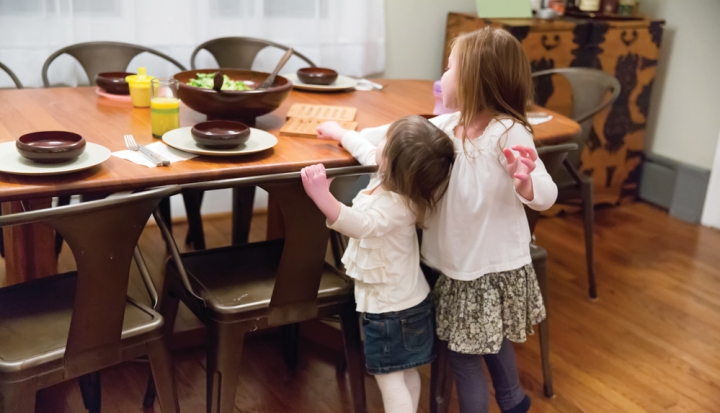As Agnes Meehan’s first granddaughter, I had the distinct honor of being selected to help her prepare for her annual Christmas Eve party when I was about 8 years old.
I recall how my grandmother shared with me her “secret recipes” and put my eagerness to help to good use. I shook small, angular chicken wings in a large lidded bowl, coating them with bottled teriyaki sauce, some of which we poured into a bowl for basting the wings as they baked. Then she tasked me with preparing my sister’s favorite dish. I removed and rinsed tiny hot dogs from their packaging and wrapped them in triangles of Pillsbury crescent roll dough that puffed into flaky, buttery pigs in blankets when baked. I watched as my grandmother made pork spare ribs with more bottled sauce, rolls from a package, and arranged a plate of sliced deli meats and cheeses. “Antipasti,” she informed me. I whisked together dipping sauces from seasoning packets, sour cream, and mayonnaise.
Then we set the table. My grandfather had inserted the three leaves to expand the dining table so that it took up almost the entire room in one long rectangle. It would serve as a buffet. The party would be a feast but not a seated dinner. I helped iron tablecloths, polish silver, and open package after package of festive cocktail napkins my grandmother had purchased on clearance after Christmas the previous year.
When she pulled out from the pale green buffet cabinet a sparkling Waterford crystal punch bowl and ladle, I was delighted. She handed me the ladle and gave me a treasure hunt: Find the Waterford stamp. Nothing was as pretty as the way these crystal pieces shimmered as they caught the light from the dining room chandelier. I was intrigued by the challenge and excited by the permission to both hold and turn the ladle over in my hands. While I hunted for the miniscule branding stamp, she filled the punchbowl with a rosy-hued concoction of champagne, 7 Up, and pink sherbet.
In hindsight, I laugh at my childhood conviction that my grandmother was the most amazing cook in all of Massachusetts. Her decidedly semi-homemade culinary style, however, did not impede upon her ability to host the best feasts, whether Christmas Eve celebrations, lunch at her kitchen table, or an afternoon picnic on the beach. There were always brightly colored napkins, utensils, a cold beverage. Every occasion for eating was well planned. When I’d spend the night, she’d set a TV tray arranged lovingly with snacks for noshing while we watched Jeopardy! together.
That she did so lovingly is key, because, while I certainly learned how to set a proper dinner table from my grandmother—salad fork, dessert spoon, butter knife, and all—no occasion for eating was unaccompanied by some gesture of profound hospitality. “Welcome,” she intimated with each carefully chosen utensil or table linen. “I’m so glad you’re here.”
I believe that my grandmother’s interest in setting the table was always more than just attention-to-the-rules etiquette. Surely these rules—outlined in many a cookbook or women’s magazine—provided a framework for various social situations. And such guidelines were helpful to her as they were to my mother and are to me today. I’ve occasionally flipped open the back of the classic Joy of Cooking for the illustrated map of table settings and suggestions for how to carve a turkey at the dinner table.
But my grandmother seemed to understand that setting a beautiful table shouldn’t merely be a sign that the host knows how to set a beautiful table—and has the china and silver to do so. A beautiful table (or picnic blanket or TV tray) should first and foremost be a sign of hospitality, a gesture to let guests know that their company is welcome and enjoyed. Table settings are also just practical. If a salad is served at the beginning of a meal, then the salad fork should be the first in a line of forks to pick up. Having multiple forks recognizes that the main course—traditionally a piece of meat—likely needs sturdier, longer fork tines.
Lately, I’ve been helping out a group of women at my church prepare the table for Holy Communion. When we meet on Saturday mornings to wash and iron linens, polish silver, and dust the chapel, I can’t help but recall those weekends with my grandmother preparing for her Christmas parties. Indeed, we are truly preparing for a feast like the ones my grandmother held, but this one is the Eucharistic feast.
While we work from a set of guidelines tucked into a sheet protector fastened in a fat 3-ring binder, the women I work with, like my grandmother, embrace what’s at the heart of these guidelines: practical needs and a sense of welcome. Hands should be washed before preparing a meal. And so, we fill a small pitcher of water and a lavabo (a hand towel) for the priest. We fold square linens—purificators—in such a way that they hang over the chalice on each side. These linens are for wiping lipstick—and, ostensibly, germs—from the shared communion cup between sips from each person who comes to the table. One woman in my group told me the way I could remember the name of this linen was by thinking about how it’s possible that priests used to pour wine through it so as to strain sediment and impurities from what would become the blood of Christ.
As I fold and iron, I think about helping my grandmother and what these practical gestures will say to those who come to the church the following morning. I pray that the crisp folds are like little signs that say, “Welcome. We’re so glad you’re here.”
At my own table, I applaud if our family is able to eat free from encroaching laptops, phones, books, and paperwork. Because there are three of us—my husband, son, and me—we occupy one end of our dining table. We hardly ever eat from matching plates. We don’t even always eat the same food. But I hand out cloth napkins and begin every meal by filling glasses with water, wine, and beer. I make sure everyone has a utensil for eating before I sit down. And, regardless of whether we’re scarfing grilled cheese sandwiches or feasting on braised short ribs, I usually light a candle in recognition that we’re eating together and glad of it. I think Agnes Meehan would be proud.
A version of this article also appears in the June 2017 issue of U.S. Catholic (Vol. 82, No. 6, pages 31–32).












Add comment